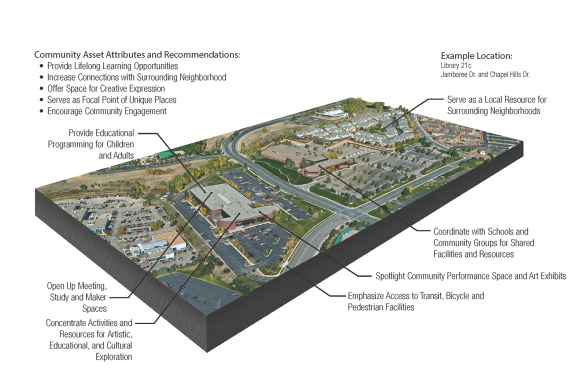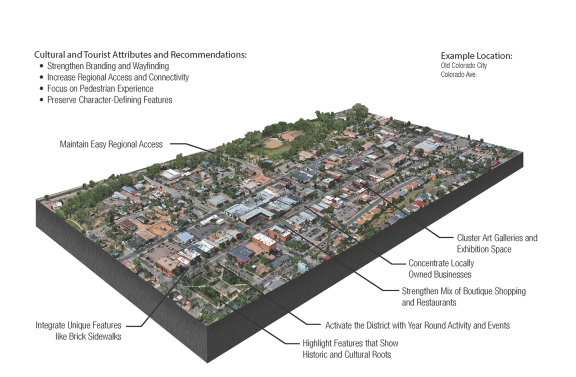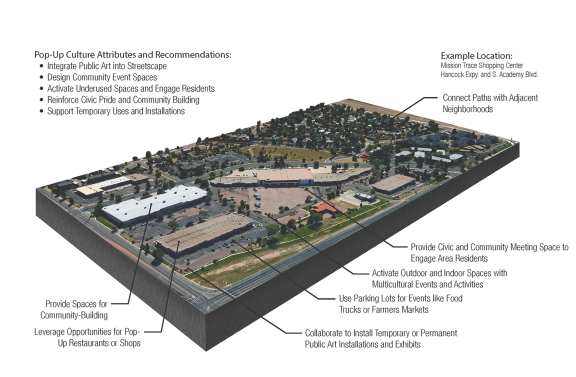Our Renowned Culture typologies are intended to help focus on, support, and grow those places and spaces within our community that are most important to the value and expression of our history, arts, culture, education, and tourism. They are also intended to assist us in infusing these values throughout more of our community. Some of these renowned culture typologies (or particular examples of them) have well defined boundaries and desired characteristics. In other cases, both the boundaries and the characteristics may be much more organic and less predictable.
Some of our most cherished cultural places combine aspects of more than one typology. For example, Old Colorado City would clearly combine elements of Typologies 3, 4, 5, and possibly 6 below.
Renowned Culture typologies are as follows:
- Defining Institutions
- Community Assets
- Historic Districts
- Creative Districts and Corridors
- Cultural and Tourist Attractions
- Pop-Up Culture
Typology 1: Defining Institutions

The goal of this cultural typology is to reinforce the city’s cultural cornerstone institutions, to foster the creation of new ones, and to empower additional collaboration and leadership among these institutions, the City, and the remainder of the community.
Colorado Springs has numerous exceptional cultural and educational institutions that put us on the map regionally, nationally, and internationally. These facilities and their organizations provide foundational cultural centers for our citizenry and offer a wide range of arts, education and cultural activities and resources, from classes to performance space. They often collaborate and partner with other community organizations, strengthening the cultural fabric of the region and attracting world famous talent.
- Examples: University of Colorado-Colorado Springs, Olympic Training Center, Olympic Museum, Colorado Springs Fine Arts Center, Colorado College/ Cornerstone Arts Center, Pikes Peak Center for Performing Arts, Colorado Springs Pioneers Museum, Broadmoor World Arena and Cheyenne Mountain Zoo, and Ent Center for the Arts. Refer to the Framework Map for additional places.
Typology 2: Community Assets

The goal of this cultural typology is to increase access and foster thriving arts, education, and cultural organizations and resources at all levels and throughout the city.
This typology recognizes the remarkable strength of non-profits, community organizations, and public resources associated with our renowned culture. Many of these assets are geographically distributed throughout the city, including libraries, schools, and community centers. They provide access to and create environments for lifelong learning, creative expression, and community engagement.
- Examples: Public libraries, community colleges, K-12 schools, community centers, YMCAs, Colorado Springs Convention and Visitors Center, Silver Key Senior Services, and Tim Gill Center. Refer to the Framework Map for additional places.
Typology 3: Historic Districts

The goal of this cultural typology is to plan for, preserve, protect, and allow for ongoing adaptive use and reinvestment in districts with an established historic identity and values.
Historic Districts encompass many of the important historical assets and neighborhoods within Colorado Springs that require conscientious development and design standards. These districts are characterized by significant historical features and character that invoke a visual memory of our city’s heritage. Identification as part of an historic district typology is not intended to imply that any or all of that area has or should have special zoning designations such as overlay zoning.
- Examples: Historic North End, Historic Old Colorado City, Westside historic areas, and North Weber/Wahsatch historic areas. Refer to the Framework Map for additional places.
Typology 4: Creative Districts and Corridors

The goal of this cultural typology is to create supportive environments for creative organizations, artists, and enthusiasts to live, work, and share ideas.
Creative Districts and Corridors include areas with clusters of arts organizations, galleries, and public art. These areas bring artists, arts organizations, and artistic activity to the forefront though the integration of studio space, live/workspaces, and creative placemaking projects. While Downtown Colorado Springs is currently the only state-certified Creative District in Colorado Springs, this typology is intended to encompass other areas that bring together the combination of arts, innovation, and the creative class.
- Examples: Colorado Springs Downtown Creative District, Old Colorado City, Cottonwood Center for the Arts, Artspace Live/Work Space, Creative Corridor along Colorado Ave. and Manitou Ave., and future arts and creative districts. Refer to the Framework Map for additional places.
Typology 5: Cultural and Tourist Attractions

The goal of this cultural typology is to recognize, protect, and enhance the values associated with special places in our community, including those most important to our tourism industry.
Our city’s culture is quintessentially associated with our places and attractions. These places may have other primary roles and functions, but their attributes usually exhibit our city’s unique heritage or have a particular association with the arts and to destinations that draw residents and visitors alike. In some cases, these districts and places encompass iconic landscapes, like Garden of the Gods, but they also include retail and mixed use areas with a focus on culture.
- Examples: Garden of the Gods, America the Beautiful Park, Memorial Park, Downtown, Old Colorado City, and the Broadmoor. Refer to the Framework Map for additional places.
Typology 5: Pop Culture

The goal of this cultural typology is to support community events and exhibitions that celebrate the diversity of Colorado Springs, activate public space, and engage residents of all ages and backgrounds throughout the city.
This typology celebrates the temporary or rotating access to culture in the form of events, festivals, tours, and non-permanent public art exhibits. They are found throughout our city, from neighborhood block parties to parades and event with a citywide draw. Pop-up culture occurs in tandem with all other cultural typologies, in neighborhoods and activity centers, in parks and along streets. It can passively engage residents and visitors, with public art displays, or actively engage with guided tours and activities. These events reinforce civic pride, community engagement, and community building.
- Examples: Art walks; street breakfasts; Porchfests; farmers markets; food trucks; Art on the Streets; outdoor concerts in parks; and community gathering areas.
